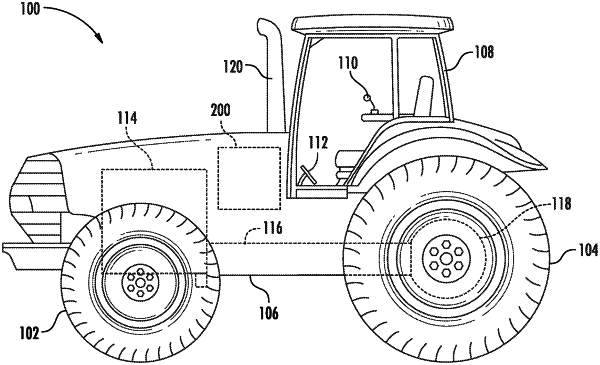| CPC F01N 3/2066 (2013.01) [B01D 53/9418 (2013.01); B01D 53/9431 (2013.01); B01D 53/9495 (2013.01); B01F 23/2132 (2022.01); B01F 25/31 (2022.01); B01F 25/431 (2022.01); F01N 3/2892 (2013.01); F01N 13/008 (2013.01); B01F 25/43171 (2022.01); F01N 1/088 (2013.01); F01N 3/206 (2013.01); F01N 3/208 (2013.01); F01N 13/082 (2013.01); F01N 2240/20 (2013.01); F01N 2330/38 (2013.01); F01N 2610/08 (2013.01); F01N 2610/146 (2013.01); F01N 2610/1453 (2013.01); F01N 2900/1402 (2013.01)] | 20 Claims |

|
1. An exhaust treatment system for a work vehicle, the system comprising:
a diesel oxidation catalyst (DOC) system configured to inject an exhaust reductant into engine exhaust;
a mixing conduit coupled to the DOC system, the mixing conduit being configured to receive a mixture of the exhaust reductant and the engine exhaust from the DOC system;
a selective catalytic reduction (SCR) system coupled to the mixing conduit, configured to react the mixture of the exhaust reductant and the engine exhaust received from the mixing conduit with a catalyst to generate a treated exhaust flow, the SCR system including an SCR outlet for expelling the treated exhaust flow therefrom;
a flow conduit in fluid communication with the SCR outlet for receiving the treated exhaust flow expelled from the SCR system;
an exhaust sensor positioned within the flow conduit downstream of the SCR outlet, the exhaust sensor being configured to detect an amount of an emission gas present in the treated exhaust flow; and
a flow mixer positioned upstream of the exhaust sensor and within the SCR system, the flow mixer comprising:
an end wall defining sector openings extending in a circumferential direction of the flow mixer between a first sector side and a second sector side and in a radial direction of the flow mixer between a radially inner sector end and a radially outer sector end; and
a plurality of swirler vanes, each of the plurality of swirler vanes extending in the circumferential direction from the first sector side of a respective one of the sector openings and in the radial direction between a radially inner vane end and a radially outer vane end, the radially outer vane end of each of the plurality of swirler vanes being spaced apart in the radial direction from the radially outer sector end of the respective one of the sector openings,
wherein the plurality of swirler vanes is configured to impart a spiraling flow trajectory to the treated exhaust flow flowing from the SCR to the exhaust sensor.
|
|
18. A flow mixer for use within an exhaust treatment system of a work vehicle, the flow mixer comprising:
a sidewall extending between an upstream end and a downstream end along an axial direction, the sidewall defining a plurality of sidewall openings, each of the plurality of sidewall openings extending in the axial direction across a first axial range;
an end wall coupled to the sidewall proximate the upstream end, the end wall defining sector openings extending in a radial direction of the flow mixer across a first radial distance; and
a plurality of swirler vanes, each of the plurality of swirler vanes extending in a circumferential direction of the flow mixer from a respective one of the sector openings and in the radial direction across a second radial distance and in the axial direction across a second axial range,
wherein the second radial distance is less than the first radial distance, and
wherein the first axial range at least partially overlaps the second axial range.
|